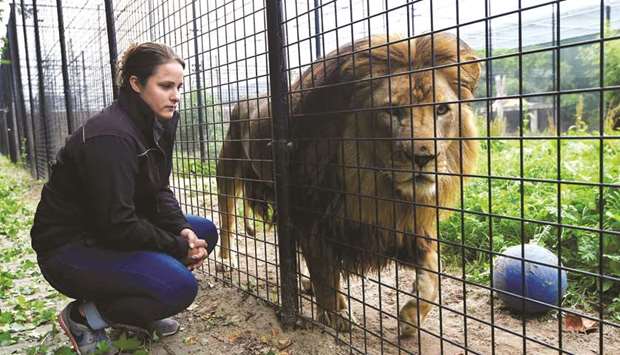With her hunter’s instinct taking over, the big cat runs down her “prey” across the rocks and ponds of an artificial savannah at a lion sanctuary north of Amsterdam, then hooks her claws into her quarry after a spectacular leap.
Perhaps one day, thanks to this unique hunting simulator manipulated by a joystick, former circus performer Dumi will be able to hunt on African plains.
“It’s a system which is meant to train the animals and not only give them back a little of their instinct, but also improve their motor control, their muscles, strength and reactions,” said Daphne Pels, a keeper at the Stichting Leeuw (Lion Foundation) refuge.
There are 35 wild cats at the sanctuary in the small town of Anna Paulowna, some 80km north of Amsterdam.
Most have been born in captivity, and the foundation aims to get the big felines — lions, tigers, cougars and leopards — back into peak condition to improve their lives and ultimately, even to hunt in the wild.
The cats were mostly rescued from inexperienced and sometimes malicious private owners.
Some are survivors of circuses that used wild animal acts — now partially or totally banned in some EU countries — and find it too expensive to feed the rapacious carnivores that can devour up to 6kg of meat a day.
Like Omar. Used as a cub by a circus to attract tourists who could hug the baby lion for selfies, Omar was eventually sold to a Slovakian mafia boss, who kept him in his garden as a pet.
When the foundation rescued Omar in March 2015, the male lion suffered from advanced malnutrition and was basically just skin and bones, with no muscle, and covered in sores and faeces.
It took Omar two years to recover. He now sports a large fawn-coloured mane, but he bears a scar on his muzzle and his small, amber eyes remain vigilant and mistrustful.
“These are animals that depend on humans a lot because they were bottle-fed, born in the circus and declawed” by their tamers or owners, said Pels.
“We can’t just put them back in the wild,” she told AFP.
Now Sarabi, the lioness, and Ambra and Laxmi, two tigresses, regularly train in this “playground” of roughly 80m by 50m, which took three years to build.
Prey can vary: sometimes it’s a toy, sometimes a piece of meat and even, when there’s no audience, a dead rabbit or pigeon to help rekindle their hunting instincts.
The cats’ target is suspended a few feet up in the air and moved around in a random fashion by keepers using the joystick in a small control room.
The aim is to push the cats, which have sometimes become lazy in captivity, to chase their prey.
The small, artificial savannah is dotted with obstacles such as rocks, pools and tree trunks “so the animals have to learn how to watch and run at the same time,” Pels said.
“The first few times we see them maybe bump their noses or accidentally fall into the water,” she said laughing.
Training is adapted to each individual depending on its physical condition, age and needs.
“We are able to give the animals some training (too), but it’s natural training. They don’t have to jump through a hoop.”
Established in 2011 by a passionate businessman and financed through private donations, the foundation hopes to relocate Omar back to Africa this year “to give him a family.”
Relocation costs 25,000 euros ($29,700).
Now aged five, Omar will join five other lions already living at the Emoya sanctuary in the Bahati wildlife estate in northern South Africa.
Two Bengal tigers are also expected to join the Wildlife Friends Foundation of Thailand (WFFT).
Once in their new homes, the felines have to learn to adapt.
Those too dependent on humans will live in a small one- to two-acre area of savannah.
Others move on to the next stage, living in an enclosure of 50 to 100 hectares learning to hunt for real.
But it’s a long-term project.
“We have to start with small prey and have to observe whether they will develop skills” to be able to feed themselves before introducing larger animals, Pels said.
“For now the most important thing is to bring the animals to Emoya to upgrade their lives and free up space for new animals that need help,” Pels added.
This includes elephants, which the foundation hopes to take in in the future.



